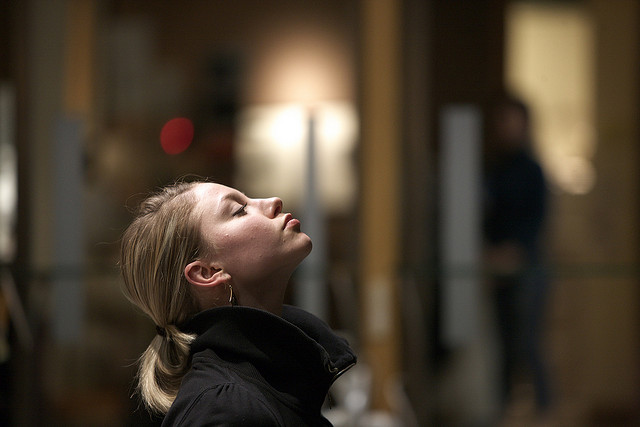
Our culture is fueled by neurosis.
The major questions that encompass public dialogue are, “How Much?” and “How soon?”
Both are clear-cut examples of our profoundly materialistic narrative. We want action, and we want it now. When we cease to get it, we react in the same manner as a child when she doesn’t get her toy.
This state of perception comes at a tremendous cost—for when we proceed in this fashion, we invariably come to be detached from the present moment, which is of course the very source of our power existentially.
The past couple years of my life have given more and more weight to this overwhelming and quite startling cultural fact, for as I’ve delved deeper and deeper into self-inquiry and spiritual practice, I have developed a drastically different—and much more fulfilling—relationship with the world around me.
Through this personal inquiry and internal cultivation, one thing has come to be abundantly clear to me: If we might come to wholly embody present moment experience and step fully into the here and now, we will transcend this cultural neurosis and come to tap into our deepest strength. This is the art of presence.
The mind is an impenetrable force, as the philosopher Nietzsche proclaimed. When we take a moment to observe the movements of our thoughts, this is rather clearly seen. I know that when I engage in this practice, I am quite alarmed at the vicious and trivial cycles that I tend to see:
“You are not enough.”
“You must do better.”
“You can’t do it.”
If it wasn’t culturally normalized, we would assume that these inner-compulsions deem us totally insane, and we would be right to assume this.
It is embedded in the very coding of thought to be detached from the present moment. When one is entirely immersed in the now, the mind comes to be very still, very quiet, very serene. This isn’t to say thought is useless or vapid, but surely as a collective we have lost touch with this sense of being aligned with the immediacy of felt experience.
It is not that certain thought processes are neurotic, but rather that all thought processes are neurotic—and unless we come to balance the movement of thought with this sense of immediate experience, this quality of presence, we will suffer.
In my own experience, this has surely proven to be the case. When I fail to move in alignment with the present moment, I am out of touch with felt experience and my deeper nature, and I feel like something is profoundly wrong within me. It is like losing a sense of being at home, feeling as though I am living in a foreign universe.
So, how might we come to be here now? How might we engender this quintessential balance so as to realign ourselves with our deeper nature and proceed forth with power?
It’s rather simple, but like many valuable things, it is so utterly simple that we most often glance over it.
Nothing must necessarily be “done,” as such—instead, we are merely allowing our most natural inclinations to unveil.
Though, of course, there are many tools of the trade to be implemented here to facilitate this process—being that we have come to be so thoroughly detached from these natural inclinations. The first would be that of bringing the whole of one’s attention to the oscillations of the breath.
The breath is the most accessible passageway to the present moment. When awareness is brought to the breath, light is shed upon the now. We then exist in a state of presence and equanimity. Here, the truth is most wholly seen. One is in the optimal position to make concise and rational decisions. To live with presence is to elicit a deep quality of peace and joyousness.
When I come to abide in my breathing in this manner, I feel a sense of inner connectedness. I feel as though I am one with my body, rather than constantly living in my head. My movements through life come with a kind of inexplicable “rightness,” as though nothing could go awry. I feel close to God, in all senses of that word.
Another tool to be utilized in this capacity is that of observing the movements of one’s own mind, which is to say self-observation. As we said earlier, when we observe our thoughts, we come to realize how crazy we are, but that realization itself is the very source of our sanity.
To be aware of the processes of our own thoughts is to invariably step fully into the present moment. This could be aptly denoted as “the awareness of awareness.” When the mind is rightly attended to, then our inner-fluctuations are no longer unconscious.
Another modality available in the evocation of presence is that of artistic expression. When one is immersed in creation, invention, and conception, the immediacy of present moment experience is abided in. Artistry brings us upon the here and now, for to be engaged in artistic endeavors is to be in alignment with our deeper perceptual inclinations.
For me, writing acts as a kind of spiritual solace in that I am expressing myself fully, and at the same time, feeling as though I am in line with something much greater than myself. It is my chosen modality in the field of artistry, and it allows me to assimilate the whole of my being into what is most felt and experiential.
There are many ways to be here now, but the underlying sentiment is that there is no rubric or construct that can encompass the art of being present. It is more so a matter of freeing oneself from all constructs, all conditioning, and all forms of structure, for it is only once we have transcended our programming that we can tap into our deepest and fullest potential as human beings.
This is where I am most myself.
~
~
~
Author: Samuel Kronen
Image: Minoru Nitta/Flickr
Editor: Travis May





Read 0 comments and reply